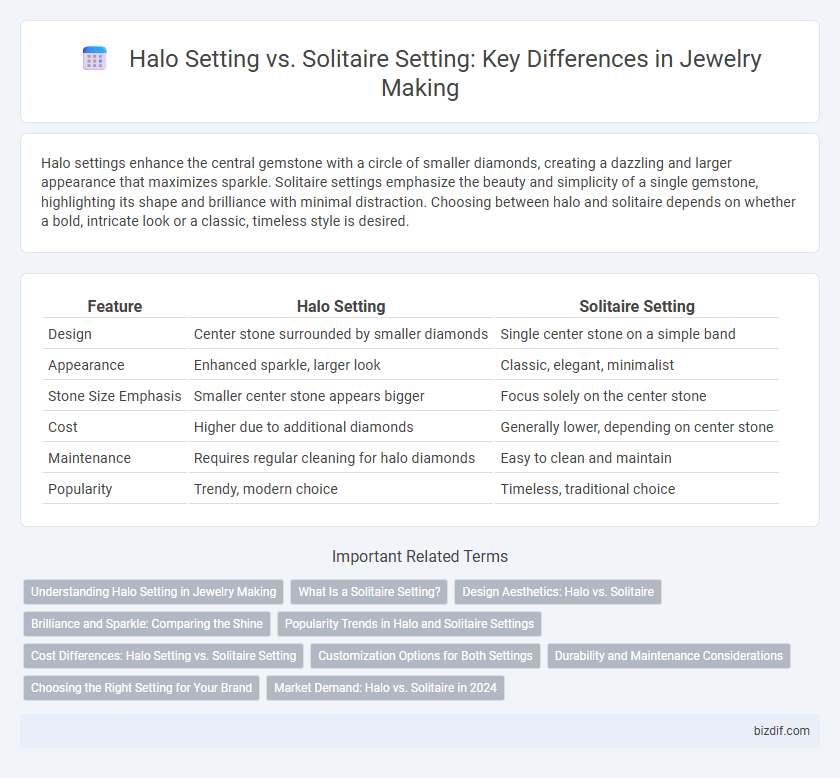Halo settings enhance the central gemstone with a circle of smaller diamonds, creating a dazzling and larger appearance that maximizes sparkle. Solitaire settings emphasize the beauty and simplicity of a single gemstone, highlighting its shape and brilliance with minimal distraction. Choosing between halo and solitaire depends on whether a bold, intricate look or a classic, timeless style is desired.
Table of Comparison
| Feature | Halo Setting | Solitaire Setting |
|---|---|---|
| Design | Center stone surrounded by smaller diamonds | Single center stone on a simple band |
| Appearance | Enhanced sparkle, larger look | Classic, elegant, minimalist |
| Stone Size Emphasis | Smaller center stone appears bigger | Focus solely on the center stone |
| Cost | Higher due to additional diamonds | Generally lower, depending on center stone |
| Maintenance | Requires regular cleaning for halo diamonds | Easy to clean and maintain |
| Popularity | Trendy, modern choice | Timeless, traditional choice |
Understanding Halo Setting in Jewelry Making
Halo setting in jewelry making features a central gemstone encircled by a ring of smaller pave-set diamonds, amplifying the overall sparkle and perceived size of the centerpiece. This design enhances brilliance and creates a vintage or glamorous aesthetic, contrasting with the simplicity and focus on a single stone found in solitaire settings. Jewelers select halo settings to maximize light reflection and provide added security to the central gem, making them popular choices for engagement rings and statement pieces.
What Is a Solitaire Setting?
A solitaire setting features a single central gemstone, usually a diamond, held by prongs or a bezel to maximize light exposure and brilliance. This classic design emphasizes the stone's size and clarity, making it the most popular choice for engagement rings. Unlike halo settings, which surround the center stone with smaller diamonds, solitaire settings offer a minimalist and timeless appeal.
Design Aesthetics: Halo vs. Solitaire
The Halo setting enhances the central gemstone with a surrounding circle of smaller diamonds, creating a brilliant, eye-catching sparkle that amplifies the overall size and brilliance of the ring. In contrast, the Solitaire setting emphasizes simplicity and elegance, highlighting the singular stone as the focal point with minimal distractions. Halo settings offer a more ornate, glamorous look, while Solitaire settings appeal to those who prefer classic, understated beauty.
Brilliance and Sparkle: Comparing the Shine
Halo settings amplify brilliance by surrounding a central stone with smaller diamonds, creating a dazzling sparkle that enhances overall shine. Solitaire settings emphasize the purity and brilliance of a single gemstone, allowing maximum light reflection and a classic, elegant sparkle. The halo setting intensifies radiance through added facets, while the solitaire highlights the stone's innate sparkle with simplicity.
Popularity Trends in Halo and Solitaire Settings
Halo settings have surged in popularity due to their ability to enhance the central gemstone's brilliance by surrounding it with smaller accent diamonds, appealing to those seeking extra sparkle and a vintage-inspired look. Solitaire settings maintain enduring popularity for their timeless elegance and focus on showcasing a single, prominent diamond, favored by minimalists and classic design enthusiasts. Market trends indicate younger buyers are increasingly drawn to halo styles, while solitaires remain preferred for traditional engagement rings.
Cost Differences: Halo Setting vs. Solitaire Setting
Halo settings typically have higher costs due to additional materials and labor involved in surrounding the center stone with smaller diamonds, increasing overall craftsmanship and diamond weight. Solitaire settings are generally more affordable as they focus on a single central diamond without extra accent stones, requiring less intricate metalwork. Buyers often find halo rings more expensive but visually larger, while solitaire rings offer a classic look at a lower price point.
Customization Options for Both Settings
Halo settings offer extensive customization options, allowing jewelers to add various gemstones, metal types, and intricate designs around the center stone, enhancing brilliance and making the piece more elaborate. Solitaire settings focus on showcasing a single center stone, but customization occurs through choices in band style, metal, and stone shape, providing a timeless and minimalist aesthetic. Both settings accommodate personalized engraving and metal finishes, tailoring the jewelry piece to individual preferences and unique style.
Durability and Maintenance Considerations
Halo settings provide enhanced protection for the center stone by surrounding it with smaller diamonds, which helps absorb impact and reduce the risk of damage, making them more durable for everyday wear. Solitaire settings expose the center stone more directly, increasing the likelihood of chips or scratches, but their simpler design typically requires less maintenance and easier cleaning. Regular inspection of prongs is crucial for both settings to ensure the security of the stones and maintain overall durability.
Choosing the Right Setting for Your Brand
Selecting the right setting for your brand involves evaluating the Halo setting's ability to amplify a center stone's brilliance with a circle of smaller diamonds versus the Solitaire setting's focus on showcasing a single, prominent gemstone. Consider your target market's preference for elaborate elegance or minimalist sophistication to align design with customer demand. Emphasize quality craftsmanship and gemstone cut compatibility to ensure your jewelry stands out in competitive retail or bespoke collections.
Market Demand: Halo vs. Solitaire in 2024
Market demand in 2024 shows a robust preference for halo settings, driven by their enhanced brilliance and perceived value, capturing 62% of engagement in luxury jewelry segments. Solitaire settings maintain strong appeal for minimalist and classic style consumers, accounting for approximately 38% of market interest, especially among younger buyers seeking timeless elegance. Jewelry retailers report a growing trend toward customizable halo designs, indicating a shift in consumer preference toward personalization within this category.
Halo setting vs Solitaire setting Infographic

 bizdif.com
bizdif.com